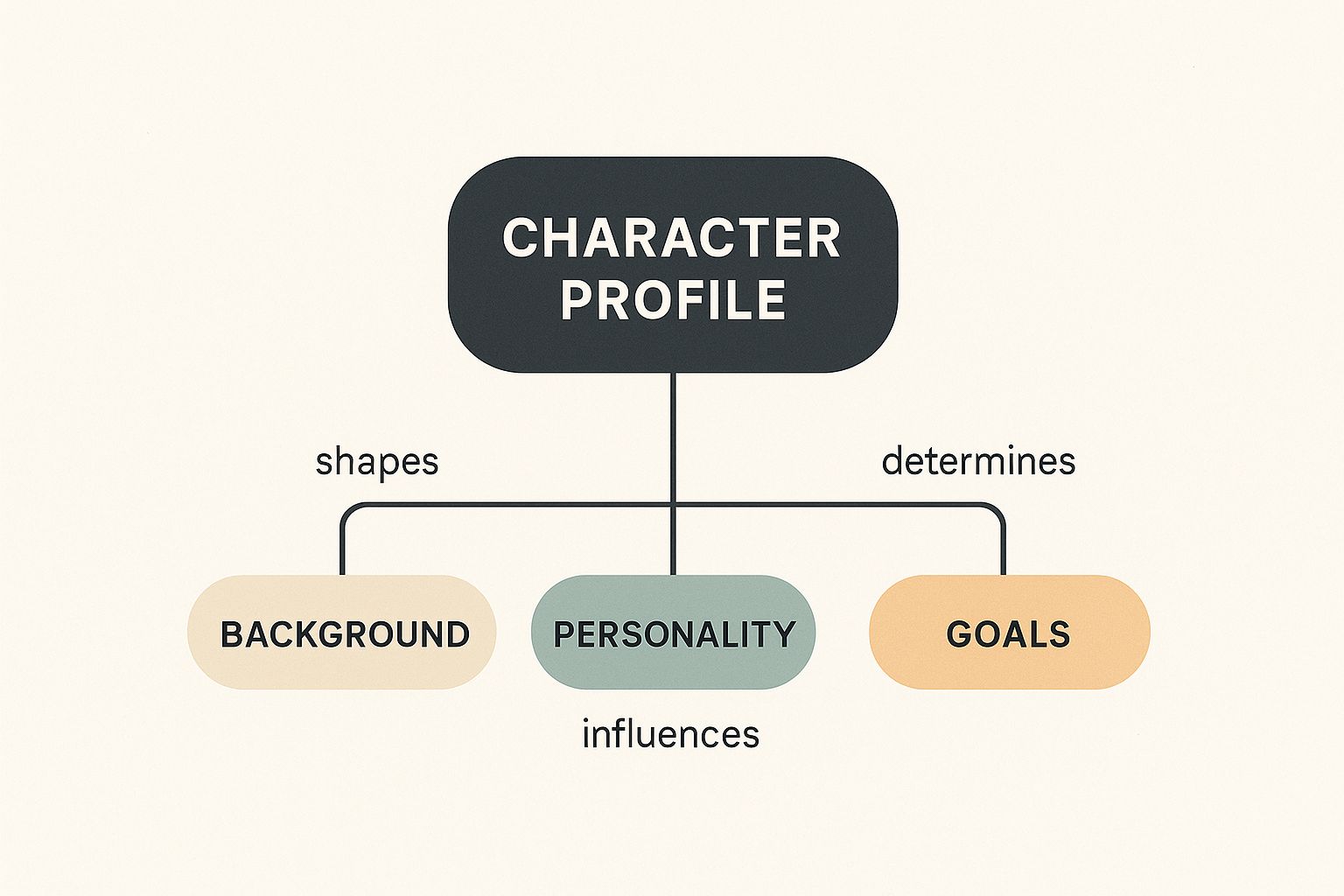Create Your Own AI Girlfriend 😈
Chat with AI Luvr's today or make your own! Receive images, audio messages, and much more! 🔥
4.5 stars

So, you have an idea for a story. Maybe it's a spark of a plot, a fascinating world, or a single, powerful scene. But before you dive into writing Chapter One, there's a critical step that separates good stories from unforgettable ones: getting to know your characters.
This isn't just about jotting down their hair color and favorite food. Writing a character profile is the art of breathing life into a concept, creating a blueprint for a believable, consistent, and genuinely compelling person who will drive your narrative forward.
Why Character Profiles Are a Writer's Secret Weapon

Before a single line of dialogue is written, the real work begins. Think of character profiling less as a chore and more as the engine that powers your plot, conflict, and the emotional heart of your story.
You wouldn't build a house without a blueprint, right? A character profile serves the same purpose. It gives your story structural integrity, ensuring every action, decision, and spoken word feels earned and authentic. Without this groundwork, you risk creating characters who feel flat, make choices that don't add up, and ultimately, leave your readers feeling disconnected.
The Core Components of a Character Profile
To start building that blueprint, you need to know what materials to gather. A solid profile covers everything from the surface-level details to the hidden psychological drivers. It’s a mix of the observable and the internal.
Here’s a breakdown of the essential categories I always include when I'm fleshing out a new character.
| Component Category | What to Include | Why It Matters for Your Story |
|---|---|---|
| Demographics & Vitals | Name, age, gender, ethnicity, occupation, education, physical appearance (height, build, eye/hair color). | Establishes the character's basic identity and how the world initially perceives them. It's the first layer of consistency. |
| Backstory & History | Key life events, family background, childhood experiences (positive and negative), past traumas, significant relationships. | This is the "why" behind their personality. Their past directly shapes their present fears, desires, and worldview. |
| Personality & Psychology | Core traits (introvert/extrovert), temperament, habits, quirks, fears, pet peeves, mental state. | Moves beyond the surface to define how they act and react. This is where you find the nuances that make them feel real. |
| Motivations & Goals | Deepest desires (conscious and subconscious), short-term and long-term goals, personal ambitions, core values. | This is the engine of your plot. What your character wants, and how far they'll go to get it, creates the story's central conflict. |
| Relationships & Connections | Family, friends, rivals, mentors, romantic interests. How do they see others? How do others see them? | No character exists in a vacuum. Their relationships reveal different facets of their personality and create subplots and tension. |
Thinking through each of these areas doesn't just fill out a form; it forces you to make connections. You might realize their fear of commitment stems directly from their parents' messy divorce, a detail you can then weave into the narrative.
Keep Your Story Straight and Avoid Plot Holes
One of the most practical benefits of a detailed profile is maintaining consistency. I've been there—realizing a character's eye color changed from blue in chapter one to brown in chapter ten. It's a small mistake, but it can instantly shatter a reader's immersion.
A well-documented profile becomes your story's bible. It's the single source of truth for everything from their birthday to their deepest phobia. This simple reference document saves you from embarrassing errors and the headache of backtracking through hundreds of pages to fix an inconsistency.
This level of detail is also a secret weapon for plotting. Knowing your character inside and out helps you anticipate their reactions, making the writing process faster and more intuitive. For more on this, Kindlepreneur.com offers some great insights on building this foundational blueprint.
A character profile isn't a cage that restricts your creativity. It’s a launchpad that gives you the freedom to explore the story, knowing your character’s foundation is solid and their reactions will always be true to who they are.
Uncover What Truly Drives Your Characters
Why does your hero risk everything for a cause? What is the villain’s ultimate, twisted goal? The answers are rooted in their motivations, which are born from their backstory, values, and hidden desires. A character profile forces you to dig deep into this all-important "why."
- What do they want most? This core desire becomes the engine of your plot.
- What are they terrified of? This becomes the source of your story's conflict and tension.
- What lines won't they cross? Their moral code dictates how they behave when the stakes are high.
When you have a firm grasp on these elements, something magical happens: your character starts to write the story for you. Their decisions feel natural and inevitable, creating a narrative that flows logically from one event to the next.
Create Characters Who Feel Real
Ultimately, the power of a character profile is in how it transforms a list of traits into a living, breathing person. By exploring their inner world, you discover the quirks, contradictions, and small details that make them feel authentic.
Instead of just describing a room, you can filter it through your character's unique perspective. A grizzled detective might immediately notice the scuff marks by the door and the crooked picture frame, while an anxious artist focuses on the oppressive shadows in the corners. This simple shift turns basic description into an act of characterization.
This is how you create characters who stick with readers long after they've finished the book. They feel like people we know, with histories we can imagine and futures we genuinely care about. That powerful connection is the ultimate goal, and it all starts here.
Building Your Character From the Outside In
Let's get practical. Forget the abstract for a moment and focus on the tangible, observable details that make a character feel real. This is what I call building a character from the outside in. You start with their external world, letting those details hint at the complex person living inside.
Think about it. Every choice, from their coat to their car, tells a story. Does your character wear a threadbare jacket? It might scream poverty, sure. But it could also reveal a sentimental attachment to a past they just can't shake. A meticulously clean car might belong to a neat freak, or it could be the one tiny island of control in an otherwise chaotic life.
These external clues are the first breadcrumbs you leave for your reader. They’re the entry point, turning a generic description into a powerful piece of characterization.
Describing Appearance with Purpose
A character's physical appearance should do more than just paint a picture—it has to reveal their personality. Instead of flatly stating a character has "brown eyes," think about how another person would perceive them. Are those eyes warm and reassuring? Or are they cold, calculating, and maybe a little unsettling?
A simple narrator might say, "The man had a scar on his cheek." But a character's observation hits harder: "She couldn't look away from the jagged white scar that cut across his cheek, a permanent reminder that this man had seen violence and survived."
See the difference? That shift turns a physical fact into an emotional interpretation, adding instant depth.
Mannerisms and Voice
How a character moves and speaks is just as critical as how they look. I've found these are the dynamic traits that truly breathe life into them on the page.
- Mannerisms: What are their unique physical quirks? Do they bite their nails when they're nervous? Tap their foot impatiently? Constantly adjust their glasses when they're deep in thought? These small, repeated actions are fantastic windows into their emotional state.
- Voice: Don't just think about what they say, but how they say it. Is their speech rapid-fire, with sharp, clipped sentences? Or do they have a slow, deliberate drawl that commands attention? Their word choice, accent, and tone can tell you everything about their background, education, and confidence level.
A grizzled detective might communicate in grunts and terse commands, while a charismatic politician uses flowing, persuasive language. Their voice is their signature. Getting it right is key to creating a character who feels distinct and memorable.
This visualization map shows how a character's background, personality, and goals are all interconnected pieces of a complete profile.
 As the map shows, you can't really develop one aspect in isolation. A character's external life (their background) is always influencing—and being influenced by—their internal world (their personality and goals).
As the map shows, you can't really develop one aspect in isolation. A character's external life (their background) is always influencing—and being influenced by—their internal world (their personality and goals).
Defining Their Place in the World
A character's identity is profoundly shaped by their environment and social roles. Their job, hobbies, and relationships provide a rich context for everything they do and believe.
Occupation and Hobbies A character's profession is an absolute goldmine for detail. An accountant, for instance, sees the world through a very different lens than a firefighter or a musician. Their job dictates their daily routine, their skillset, and the people they interact with.
What they do in their free time is just as revealing. A character's hobbies speak volumes about their passions and what they truly value.
- Someone who spends weekends restoring old furniture is probably patient, meticulous, and feels a connection to the past.
- A marathon runner might be incredibly disciplined and driven—or maybe they're just running from something.
Social Circle and Relationships Who does your character surround themselves with? Their friends, family, and even their rivals are a mirror, reflecting their own values and personality. A character who keeps a tight-knit circle of childhood friends is fundamentally different from a lone wolf who keeps everyone at arm's length.
Exploring these relationships is also a fantastic way to generate conflict, create support systems, and spin off subplots. Show how your character behaves differently with their boss versus their best friend. These shifts reveal new facets of their personality. Crafting these distinct personas is crucial, whether you’re writing a novel or exploring the different https://www.luvr.ai/characters for roleplay and conversation.
Their Personal Space Finally, take a look at their home. A character's living space is often a direct reflection of their inner life. Is their apartment obsessively clean, hinting at a deep-seated need for control? Or is it a glorious mess of books and art supplies, suggesting a creative but chaotic mind?
Every object can tell a story. A single framed photo, a stack of unpaid bills on the counter, or a perfectly tended garden can reveal more about a character's priorities and secrets than a full page of exposition. When you build from the outside in, you create a rich, textured person whose external world is a perfect mirror of their internal one.
Mapping Your Character's Inner World

A character's actions are only ever as believable as the inner world they come from. External details give us a snapshot, but the real meat of a character—the part that sticks with readers long after they finish the story—is found in their psychological and emotional core. This is where we stop just describing what they look like and start exploring who they are.
This internal map is built from their motivations, fears, deep-seated conflicts, and moral code. These aren't just abstract ideas; they're the invisible puppet strings that guide every choice your character makes. Nailing these down is how you turn a flat sketch into a living, breathing person.
Uncovering Core Motivations
Every great character wants something. Badly. This want, their core motivation, is the engine that powers them through the entire story. It’s never a surface-level goal like "I want to get a promotion." The real question is why. Why the promotion? For the power? The money? For a chance to finally earn their father’s respect?
Think of motivation as the story’s gravity. It’s what keeps your character moving, even when the odds are stacked against them. When you’re putting together a character profile, digging for that core motivation is your most important job.
A character who wants to be a famous musician, for example, might be driven by a desperate need for the validation they never got as a kid. That one detail completely reframes their journey, turning a simple ambition into a deeply personal quest.
The Power of Fear
Just as vital as what a character wants is what they're terrified of. Fear is your secret weapon for creating conflict and tension. It's the wall standing between your character and everything they desire.
A character’s biggest fears are almost always the flip side of their desires.
- A hero who craves justice might be paralyzed by a fear of failure, convinced one wrong move will let the bad guys win.
- A romantic lead desperate for love might be terrified of vulnerability, believing that showing their true self will only lead to rejection.
By pitting a character's greatest desire directly against their greatest fear, you create a powerful internal conflict. This is the heart of a compelling character arc, forcing them to confront their demons to achieve their goals.
Their fear adds stakes and makes them relatable. A fearless hero is boring. A hero who is scared to death but acts anyway? Now that’s someone we can root for.
Defining Their Moral Compass
A character’s morality is the set of rules they live by. It dictates what lines they will and won't cross, especially when the heat is on. This internal code is what makes their decisions feel consistent and earned, rather than random.
To get a handle on their moral compass, you have to ask some tough questions.
- What are their absolute truths? What do they believe so deeply they would never, ever betray it?
- Where are the gray areas? When might they bend their own rules? For love? For survival?
- What’s their red line? What is the one thing they would find unforgivable, either in themselves or someone else?
Imagine a spy whose code is "protect my country at all costs." Now, what happens when their country orders them to sacrifice an innocent person they’ve come to care about? That moment of conflict, where their moral compass is shattered, is where true character is revealed. It’s not about being "good" or "evil"—it's about the messy reality in between.
The Influence of Backstory and Trauma
A character doesn't just appear out of thin air. Their inner world is molded by their past—their wins, their losses, and especially their traumas. Backstory isn't just a list of things that happened; it's the emotional baggage from past events that dictates how they act today.
Think of past trauma as an old injury. It might have scarred over, but it still aches under pressure. A character abandoned as a child might wrestle with trust issues for their entire life. A soldier haunted by the choices they made in battle will see the world differently.
When you’re building your profile, draw a direct line from a specific past event to their current psychology.
| Present Behavior | Potential Past Trauma |
|---|---|
| Fear of Abandonment | Was left by a parent or a first love, leading to clingy or avoidant behavior in new relationships. |
| Need for Control | Grew up in a chaotic household and now micromanages their own life to feel safe. |
| Inability to Trust | Was betrayed by a close friend or family member, making them suspicious of everyone's motives. |
| Reckless Behavior | Survived a near-death experience and now lives with a "nothing to lose" attitude. |
This isn’t about creating victims. It’s about building survivors whose past gives context to their present. When you probe your character's psyche this deeply, their actions in the story will feel not just plausible, but inevitable. That depth is what makes a character profile an indispensable tool for creating figures that feel truly alive.
Bringing Your Character to Life on the Page
So, you’ve done the deep work. You have a detailed profile outlining your character’s deepest fears, secret desires, and a lifetime of backstory. Now for the real magic: getting all that brilliant material off your notes and onto the page without it feeling like a clumsy info-dump.
A great character profile is a writer's secret weapon, but it's useless if it stays locked away. The true artistry is in weaving these details into the story so naturally that the reader feels like they're discovering the character on their own.
Show, Don’t Just Tell
This old rule is the absolute cornerstone of introducing a character. It's so tempting to just write, "He was a cynical man who trusted no one," but that’s a classic misstep. It tells the reader exactly what to think, robbing them of the joy of figuring it out for themselves.
Instead of just stating his cynicism, let's see it in action. Have him roll his eyes at a stranger's simple act of kindness. Let him question the motives of someone offering help, searching for the "catch." These small moments reveal his personality far more powerfully than any label ever could.
You can also pull the reader directly into your character's head. What thoughts cross their mind that they'd never dare say aloud? Seeing the world through their private filter gives us a direct line to who they truly are.
A narrator might describe a room as messy, but a character's observation makes it personal. An anxious character might notice the dust bunnies multiplying under the sofa, seeing them as symbols of creeping chaos. A laid-back character might just see a comfy, lived-in space.
This simple shift turns basic description into a powerful act of characterization. It’s not just about what is seen, but who is doing the seeing.
Reveal Personality Through Action and Dialogue
Actions always, always speak louder than words. A character’s choices, especially when they're under pressure, will tell us more about them than a page of backstory ever could. If your profile says your character is brave, don’t just write, “She was brave.” Throw her into a situation that demands courage, even if her hands are shaking.
Dialogue is just as crucial—it's your character's fingerprint on the page.
- Word Choice: Does she use formal language, or is she all casual slang and contractions? Her vocabulary can give subtle clues about her education, social standing, and even her emotional state.
- Speech Patterns: Is he blunt and direct, or does he ramble and dance around a subject? Someone who talks a mile a minute might be nervous, or maybe they're trying to hide something.
- Subtext: What is your character not saying? So much of the tension in a good conversation lives in the subtext—the unspoken feelings and intentions simmering just below the surface.
When you blend these elements, you create a voice so distinct that your character feels real and memorable every time they open their mouth.
Map Out a Compelling Character Arc
Great characters don't stay the same. The stories that stick with us are the ones where characters face their flaws and undergo a meaningful transformation. This journey is their character arc, and your profile is the perfect tool for planning it out.
At its core, a character arc is about a person confronting their deepest fear or core flaw in order to achieve their goal. It's a journey of growth, plain and simple.
- Define the Starting Line: Your profile gives you the "before" picture. What are your character's flawed beliefs, emotional armor, and go-to defense mechanisms at the start of the story?
- Pinpoint the Catalyst: What event kicks the story off? This inciting incident should be something that yanks them out of their comfort zone and forces them to confront their worldview.
- Plan the Turning Points: Map out the major plot points where your character is tested. These are the moments that force them to question their old ways of thinking and make choices they never thought they would.
- Shape the Climax and Resolution: The climax is the final showdown with their inner demons. The choice they make here demonstrates how much they've grown, leading to their new, transformed self at the end of the story.
This journey isn’t just about the character, either. A deeply understood character, with all their nuances, can be a powerful marketing asset. By knowing them inside and out, you can portray them with an empathy that feels real—like an actor "living truthfully under imaginary circumstances." For more on this, check out these insights on using profiles for marketing on RealmChef.com. When you translate your profile into a dynamic arc, their journey becomes the heart of your story, grabbing readers from the first page and never letting go.
Tools and Templates to Streamline Your Process

While your imagination is the true engine behind any memorable character, the right tools can act as the perfect navigation system, keeping your ideas organized and accessible. I’ve seen countless writers try to manage their characters with a messy web of disconnected notebooks and sticky notes. It doesn't have to be that way. Technology now gives us some incredible ways to manage complex information and track relationships without stifling creativity.
The trick is finding a method that clicks with your personal writing style. Some writers I know thrive in the structured world of dedicated software, while others prefer the freeform, almost painterly, flexibility of a digital notebook. There’s no single “best” approach here, only the one that helps you pull that character from your mind and onto the page in a usable format.
Dedicated Writing Software
For authors juggling sprawling casts, intricate subplots, and tangled timelines, dedicated writing software can be an absolute lifesaver. These tools are so much more than a word processor; they’re designed with storytellers in mind, offering specific modules for character sheets, location details, and research notes.
Scrivener: A long-time favorite for novelists for a reason. Scrivener lets you build out detailed character and setting sketches that live right alongside your manuscript. Its virtual corkboard is brilliant for visually mapping out relationships and character arcs.
Notion: While it's not exclusively for writers, Notion's versatility is its superpower. You can design your own custom character profile databases from the ground up, linking characters to specific scenes, plot points, or other people in their lives. It’s a blank canvas.
The demand for these kinds of tools is exploding. The global Character Generator market, which includes this kind of software, was valued at around $477.4 million in 2025 and is projected to clear $2 billion by 2033. This just goes to show how many creators are turning to technology to build their worlds.
AI-Powered Character Creation
Modern AI tools bring something new to the table, acting as a creative partner to help you brainstorm and expand your ideas. They can generate unique physical descriptions, suggest potential backstory elements based on a core personality trait, or even help you flesh out a character’s speaking style.
Think of these tools not as a replacement for your creativity, but as a cure for writer's block. When you're stuck on a detail—like a unique hobby or a compelling internal conflict—an AI can provide a dozen suggestions in seconds, sparking your own imagination.
Platforms like Luvr AI, for example, are built entirely around deep character creation, allowing users to define personalities, backstories, and preferences from scratch. It’s worth exploring the various features for custom AI character design just to see how detailed and interactive modern profiles can become. It can provide some fantastic inspiration for your own work.
Finding the Right Character Profile Template
Whether you settle on sophisticated software or a simple document, a good template provides the scaffolding for your creativity. It’s your checklist, ensuring you don’t forget crucial details and prompting you to think about aspects of your character you might have otherwise glossed over.
At its core, a strong template should cover these areas:
- Vitals and Appearance: The basics—name, age, and the physical traits that hint at their personality.
- Backstory and History: The key life events that forged them into who they are today.
- Psychology and Mindset: Their deepest fears, driving motivations, fatal flaws, and moral compass.
- Relationships: A clear map of their connections to friends, family, allies, and enemies.
Ultimately, the goal is to find a system that makes writing character profiles feel less like an assignment and more like an act of discovery. Experiment with a few different tools and templates until you find one that feels intuitive. The right system will help you build a solid, consistent foundation for your story's most important asset—its people.
Common Questions About Character Profiles
As you get into the rhythm of creating character profiles, you’ll find the same questions tend to surface over and over. That's a good thing—it means you're digging deeper. Let's tackle some of the most common hurdles I see writers face, so you can build out your characters with more confidence.
How Much Detail Is Too Much?
Ah, the classic question. The honest-to-goodness answer? It really depends on what makes you tick as a writer. I’ve known brilliant authors who work from a 50-page character bible that details every scar and childhood memory. I’ve also known others who start with just a few key bullet points and let the rest emerge on the page.
The real key isn't the amount of detail, but its relevance. A great rule of thumb is to focus only on details that will actually push your story forward.
Does your character’s childhood fear of water play a pivotal role in the climax set on a boat? Absolutely, you need that in there. Do you need to know their third-grade teacher's name? Probably not, unless that teacher is about to show up in Chapter 12.
Your profile should be a living document, not a stone tablet. Start with the absolute essentials—their core motivation, their biggest fear, and one defining backstory event. You can always add more as you write. Don't let the profile become a fancy form of procrastination.
Should I Use a Template or Freeform Notes?
There's no right or wrong answer here. It's all about what gets your creative gears turning.
- Templates are fantastic when you're just starting out or if you're the kind of writer who wants a checklist to make sure you haven't missed anything crucial. They provide a solid framework.
- Freeform notes, like jotting things down in a notebook or building a mind map, can feel much more organic. This is often the preferred method for "discovery writers" who enjoy letting the character reveal themselves slowly over time.
My personal advice? Try a hybrid approach. Use a template to lay down the skeleton—the basic facts and story-critical information. Then, open up a blank page and just explore. This lets you get the structure you need without stifling the creative spark.
How Do I Avoid Making a Mary Sue or Gary Stu?
A "Mary Sue" or "Gary Stu" is that character who's just too perfect. They’re impossibly skilled, universally loved, and face no real challenges. Frankly, they’re boring.
The antidote is surprisingly simple: give them real, consequential flaws. And I don't mean a cute, endearing quirk like "being a bit clumsy." I mean a flaw that genuinely messes things up for them.
- Maybe your brilliant detective is also a pathological liar who can't maintain a relationship.
- Perhaps your brave warrior has a crippling fear of intimacy that prevents them from accepting help.
- What if your kind-hearted leader has a nasty streak of arrogance that alienates their most important allies?
These flaws need to create problems, force difficult choices, and drive your character's growth. If you're looking for more inspiration on building compelling personalities, our Luvr AI blog is packed with articles and guides on character creation.
What If My Character Feels Flat After I Profile Them?
It happens. You've filled out every field in your template, and now your character feels more like a data-entry project than a living, breathing person. When this happens, it's a clear sign to stop outlining and start writing.
Put them in a scene. It doesn't have to be anything dramatic. Just stick them in a room with another character and have them talk. What do they argue about? What secrets do they dance around? Hearing their unique voice and seeing how they react under a little pressure is often the spark that brings them to life.
Ready to put these ideas into practice? With Luvr AI, you can move beyond static profiles and create dynamic, interactive AI characters. Design their backstory, define their personality, and see them come to life in immersive conversations. Start building your perfect character today at https://www.luvr.ai.



